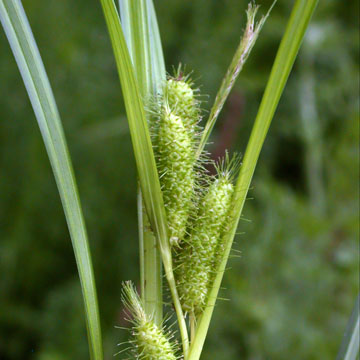

Carex frankii - (image 1 of 3)
Taxonomy
Family: Cyperaceae
Section Squarrosae
Habitat
Swamps, wet woods, wet meadows, ditches.
Associates
Distribution
VA to western NY (recently found in central NY), southern Ontario, MI, and southeast NE, south to GA and TX.
Morphology
Perennial, the stems 20-80 cm, in small tufts on rather short rhizomes, aphyllopodic; leaves up to 1 cm wide, the ligule shorter to somewhat longer than wide; terminal spike 5-30 mm, usually completely staminate, often subsessile and concealed among the pistillate ones, or short-pedunculate and exsert; pistillate spikes 3-6, usually approximate or crowded, sometimes separate or the lower ones remote, cylindric or elliptic, 1.5-3 cm long and 1 cm thick, very dense, rounded at both ends, sessile or nearly so; bracts leaf-like, 2-4 times as long as the inflorescence, at least the lower strongly sheathing; pistillate scales with concealed body and an exsert slender awn equaling or surpassing the perigyhium-beaks; perigynia obconic, inflated, the body 2.2-3.6 mm, with 2 strong ribs and several fine sharp nerves, depressed truncate at the apex and very abruptly beaked, the beak 1.3-2.3 mm with teeth 0.5 mm; achene loosely enclosed, obovoid trigonous, 1.5-2 mm, with a persistent straight style.
Notes
Fruiting June to August
Wetland indicator: OBL
Like C. squarrosa and C. typhina this species has tightly crowded perigynia each abruptly contracted to a slender beak, however the spikes are more approximate, elongate, and with long-awned pistillate scales that exceed the bodies of the perigynia. Carex aureolensis is a similar species that occurs from VA to FL, west to KS and NM.
References
Gleason, Henry A. and A. Cronquist. 1991. Manual of Vascular Plants of
Northeastern United States and Adjacent Canada. Second Ed.
The New York Botanical Garden. Bronx, NY
|
© Michael Hough 2018 |